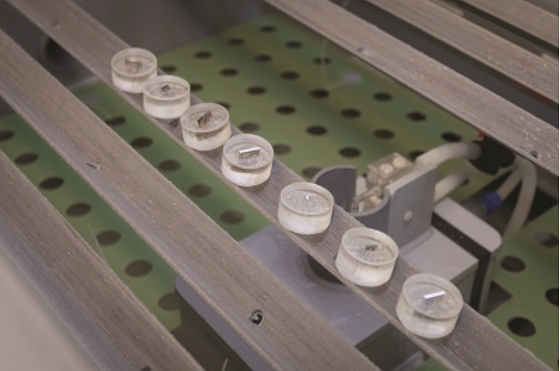Through testing and computer simulations, a research collaboration comprised of academic, government, and industrial interests is working to show that a new welding technique could make the joint between light metal alloys more resistant to corrosion. They believe these newly created welds could make automobiles more resistant to corrosive conditions, such as road salts, high humidity, and high temperatures.
Adam Powell, associate professor of mechanical engineering at the Worcester Polytechnic Institute (WPI) (Worcester, Massachusetts, USA), was recently awarded a three-year, $1.5-million grant from the U.S. Department of Energy’s Vehicle Technologies Office for the research.1
As the lead institution, WPI is receiving $750,000, while two other groups—Oak Ridge National Laboratory (ORNL) (Oak Ridge, Tennessee, USA) and Pacific Northwest National Laboratory (PNNL) (Richland, Washington, USA)—will split the remainder. Automotive parts supplier Magna International (Aurora, Ontario, Canada) is contributing in-kind time and materials to the project.
Project Goals
According to the researchers, the goal of the project is to influence future designs of durable, next-generation metal car joints used in ultra-light car doors and other vehicle body applications.
Powell explains that the automotive industry is seeking to reduce the weight of cars and trucks, while maintaining the lifespan of a car. One of the ways to do that, he says, is to use advanced lightweight materials, such as aluminum and magnesium alloys. The researchers are testing to determine if a new type of welding—known as friction stir welding—reduces corrosion in aluminum-magnesium alloy joints. Currently, any joint involving direct contact between different metals tends to suffer from galvanic corrosion, according to the researchers.
“We’re trying to show that corrosion can be much less of a problem with this new type of welding,” says Powell, who is the principal investigator on the project. “We think that this process holds a lot of promise and could make a significant impact on energy use in motor vehicles without reducing the lifespan of a car.”
Research Plan
Under the research plan, Magna provides aluminum and magnesium metals to PNNL, which welds the materials. PNNL then ships the welded parts to WPI, which conducts corrosion and mechanical testing. WPI then sends much of its tested samples to ORNL, which oversees advanced analysis on the welds. Computer simulations then take place at WPI, says Powell, “to try to understand how the corrosion and mechanical fracture work together.”
In early 2020, WPI is conducting a series of experiments in a lab using a cyclic corrosion test chamber, which stands about 3 ft (0.9 m) tall and resembles a tanning bed, according to the research team. In these experiments, Powell and a group of five other WPI researchers place the small sections of welds in rows inside the chamber. The welds are then exposed to a variety of corrosive environments, including salt spray, high temperatures up to 140 °F (60 °C), and high humidity.

“We expose the welds to a variety of conditions that accelerate the corrosion process, simulating the lifecycle of a vehicle,” Powell says. “It’s that cycling between different conditions that leads to accelerated corrosion. WPI’s goal is to use computer simulations that show with a level of confidence that the welds will last for up to 20 years, even in a harsh New England winter.”
While sodium chloride (NaCl)—commonly known as road salt—is often used in winter weather to prevent ice on roadways and maintain safe traffic flow, it can also corrode the metal parts of automobiles that travel over it. Furthermore, the chlorides do not always degrade in the environment and could pose long-term environmental risks, according to many researchers.2
With regards to the WPI team’s computer simulations, Powell says automotive companies could eventually use this simulation capability to do virtual experiments and predict corrosion over the 15- to 20-year lifespan of a car. Based on the validated model, the researchers are hoping to enable the design of welded joints that are both low-cost and robust, allowing for their use in ultra-light doors and multiple vehicle body applications.
Future Timetable
In the first year of the research, Powell and colleagues are seeking to understand the corrosion behaviors of magnesium and aluminum diffusion-bonded joints in the test chamber. In the second year, they plan to simulate on a computer both the corrosion of friction-stir-welded joints and mechanical fracture. In the final year, they plan to use the results of their earlier findings to make the models more accurate.
As a result of the research, Powell and his team are aiming to show that the new welding process will lead to more durable subassemblies made of the two dissimilar metals. Benefits include lighter vehicles, reduced fuel consumption for gas-powered cars, and longer range for electric cars. “All of these benefits will go a long way to impacting the safety, performance, and lifespan of a car,” Powell says.
Source: WPI, www.wpi.edu.
References
1 “As Winter Rushes In, WPI Researcher Uses Corrosion Test Chamber to Simulate Road Salt Impacts on Future Car Designs,” Worcester Polytechnic Institute News & Events, Dec. 12, 2019, https://www.wpi.edu/news/winter-rushes-wpi-researcher-uses-corrosion-test-chamber-simulate-road-salt-impacts-future-car (Feb. 23, 2020).
2 B. DuBose, “Researchers Propose Less Corrosive Alternative to Road Salt,” MP, Jan. 2, 2020, http://www.materialsperformance.com/articles/material-selection-design/2020/01/researchers-propose-less-corrosive-alternative-to-road-salt (Feb. 23, 2020).